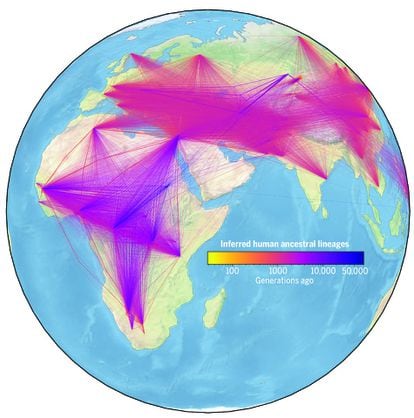A market in the city of Chennai (India). IDREES MOHAMMED (EFE)
Researchers in the US and the UK have just compiled the largest family tree in history, representing all living humans on planet Earth.
This very complex map gathers the kinship of the different current human populations generation by generation until the origin of our remote ancestors in Africa.
The tree reveals new details about the migrations of our species around the planet and can clarify crucial moments, such as the exit from Africa of a group of
Homo sapiens
72,000 years ago —or 2,400 generations— and from which all current humans descend.
"This is the largest family tree of humans and describes our origin and expansion around the world based on the genetic variations of the species," explains Wilder Wohns, a researcher at the Broad Institute (USA) and first author of this work, who is published this Thursday in the journal
Science
.
This human family tree is actually a "first draft," says Wohns.
Having the complete picture would require knowing the genome of all living humans and that of all those who have ever lived, which would add up to some 124,000 million souls since
Homo sapiens
began to exist about 200,000 years ago.
This genealogy has been compiled from various sources.
The main one is the genome of 3,601 current people who live in more than 200 different places on the planet.
Also included is the detailed genomic sequence of three Neanderthals, our closest human relatives, and a Denisovan.
The genetic sequence of a complete family of
Homo sapiens
- father, mother and two children - that lived in the Altai mountains of Russia 4,600 years ago has also been included.
This family belonged to the Afanasievo culture, which was genetically very similar to the Yamnaya, a people of horsemen and shepherds who were the protagonists of one of the most interesting and darkest chapters in history: the occupation of much of Western Europe thanks in part to a cutting-edge technology: the wheel.
The yamnaya scourge reached the Iberian Peninsula, where they almost completely displaced local men, according to a 2018 study led by the prestigious geneticist David Reich, who is also a co-author of the current work.
The new "unified genealogy" of our species also employs another 3,589 ancient human genomes.
Each person's genome contains 3,000 million letters that compile all the necessary instructions for their body to function properly.
A mistake of a few letters in that sequence can generate important changes, such as a greater ability to live in the highest places on the planet or a greater risk of developing tumors.
The new family tree analyzes more than six million genetic sequences and 245 million of those errata—mutations—to go back up the human family tree.
“The level of detail is tremendous, we have information on some 27 million ancestors of current people.
What we get is a map with lines and nodes that are used to estimate the migration routes of humans around the planet throughout the history of the human species”, highlights Wohns.
Representation of the family tree of humans with the geographical location of each lineage studied.W.
wohms
The new tree coincides very well with what was already known from paleoanthropological findings, such as that the group of sapiens from which all current humans descend lived in Northeast Africa 72,000 years ago.
The 100 oldest lineages have as their epicenter a point in northeastern Sudan.
The point could very well be on the route to Egypt and the Middle East that our ancestors followed.
The new family tree also clearly sees the genetic signal that our ancestors had sex and children with Neanderthals and Denisovans, two now extinct human groups.
There are signs of something much more disturbing: some populations in Asia and Oceania, mainly Papua New Guinea, carry genetic material from “ghost” humans;
archaic hominids of unknown species that sapiens encountered and did not hesitate to cross paths with them.
The work also detects several moments in which some human populations were about to disappear.
One of the pending applications of this new tree may be to explore what happened 74,000 years ago, when the world population was reduced to a few thousand people just after the eruption of the Toba volcano in Sumatra, which caused a climate change to colder temperatures. that lasted a thousand years.
The techniques applied to creating this tree have many more applications, Wohns argues.
“Beyond evolutionary history, there is a lot of biological research that needs to know how different human populations have evolved over time and space.
This can be done thanks to this new technique, which would also be useful for domestic animals, endangered wild species, disease vectors and genetic ailments such as cancer”, he highlights.
The Spanish researcher Aida Andrés, a specialist in population genetics at University College London, believes that this new technique has its “limitations”.
The use of old, highly degraded and incomplete genomes means that their accuracy is reduced in some cases, explains the expert in a commentary on the study signed with her colleague Jasmin Rees.
"The constant increase in genetic data will make these techniques more and more useful," they qualify, especially to include "underrepresented populations" in current genetic databases, in which samples from people in rich countries continue to be most.
CSIC geneticist Carles Lalueza-Fox believes that "this work confirms what was known with a novel analytical approach based on the genealogy of chromosome fragments [the different atoms of the genome]".
“Like any new technique, it is difficult to know what uses it will have in the future,” he adds.
You can follow
MATERIA
on
,
and
, or sign up here to receive
our weekly newsletter
.

